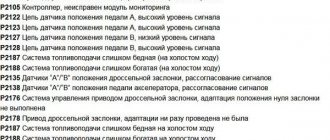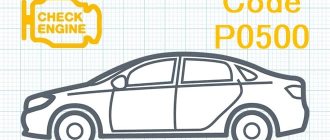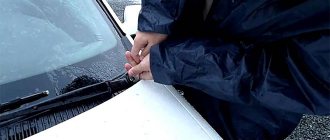The electronic on-board computer is equipped with a function to inform the driver about emerging problems in the vehicle systems. Information is provided through error codes, where each code indicates a specific failure or problem. Therefore, guided by the received codes, you can quickly find the source of the breakdown or incorrect operation and eliminate it. However, “old-style” cars do not have an ECU, so it will not be easy to look for errors in the operation of various systems. At the same time, more and more questions among owners of old and new car models are caused by errors with codes p0300, p0301 and p0302. What is the reason for this interest and why is it so difficult to identify the causes of these errors? Now let’s try to figure it out.
How does a mechanic diagnose a P0303 trouble code?
When diagnosing the P0303 trouble code, a mechanic will do the following:
- Reads all stored error codes using an OBD-II scanner
- Review all data stored in ECM memory
- Clear error codes from the ECM and test drive the vehicle to see if P0303 appears again
- Inspects major components and associated wiring for wear and damage, and performs a thorough check for leaks
- Check the misfire counter in cylinder 3
- Will check if there is an intake air leak or any problems with fuel injection
- Check the spark plugs
Recommendations for checking and troubleshooting
You should not delay engine repairs if error p0300 appears. Almost any inaccuracy in the operation of the motor during long-term operation of the power unit can cause the need for complex repairs. Most of the causes of misfire can be determined independently by using a minimum number of tools and devices to restore the performance of the power unit.
How to Diagnose Error Code P0300
Error p0300 can be diagnosed using special scanners, as well as visual and instrumental studies. Purchasing a diagnostic device will allow you to check the ignition system at any time without visiting specialized car services. Despite the expense, having your own scanner will save time and money in the future. Other ways to determine the causes of error p0300 are practically free or require minimal financial investment.
Connect your car charger
The process of finding the causes of errors can take considerable time. Most of the research is carried out with the ignition on, so it is important to maintain the battery charge at the proper level. To prevent new errors from appearing during the inspection due to a dead battery, it is recommended to connect a charger to it for the entire repair period.
Connect OBD2 scanner
An OBD2 scanner makes it easy to scan and resolve the P0300 error code. This device model is used only for diagnosing cars that were produced after 1996. If the car is older, then you should use an OBD 1 scanner.
Check wiring
If the wiring is damaged, errors may also appear indicating misfires. You should look not only for breaks or loose contacts, but also for places where the insulation has melted or abraded. In such places, current leakage to ground may occur, which can cause unstable operation of the ignition system.
Check the spark plugs
If there are signs that the ignition of the fuel mixture in one of the cylinders is impaired, then finding a faulty spark plug will not be difficult. It is much more difficult to identify an unstable part in which only minor deviations in operation are observed. Replacing all engine spark plugs will completely eliminate the cause of the p0300 error.
Inspect the distributor distributor cap
If, after replacing the spark plugs, problems with engine operation remain, you should carefully inspect the high-voltage wires and the distributor cover. If damage is found on the parts, they should also be replaced.
Check other error codes
If, as a result of using the OBD2 scanner, other errors were discovered in the operation of various engine systems, it is recommended to eliminate them first. After completing the setup and repair work, error p0300 may no longer appear.
Replace engine control unit
If all possible measures have been applied to eliminate the p0300 error, but the problem has not been resolved, then the engine control unit may need to be replaced. You can also try to reflash the unit using a special program by contacting a specialized car service center.
Errors in the operation of the ignition system are quite common. Almost all problems of this type can be resolved independently. It is recommended to start work by checking the ignition system components, the diagnosis of which will take the least time, gradually moving on to more complex studies.
Additional comments for troubleshooting P0303
To properly diagnose a P0303 trouble code, a mechanic will need an advanced scanner that will not only read stored trouble codes, but also view sensor readings in real time. This data can help determine the root cause of the error.
The recommended service interval for replacing spark plugs is usually indicated in the vehicle's service book. Worn or damaged spark plugs are one of the most common causes of cylinder misfire, especially in high-mileage vehicles. If the vehicle is equipped with an ignition distributor with a cap and slider, these must also be replaced according to the vehicle manufacturer's recommendations. These components are mechanical and wear out over time. Spark plug wires are usually replaced when the spark plugs themselves are replaced.
Newer vehicles may be equipped with ignition coils, which typically last longer than the above components. To quickly determine whether the problem is a faulty ignition wire or coil, you must move the wire and/or ignition coil to a different cylinder. If the error code appears again, it is a sign that a worn or damaged ignition wire and/or coil is causing the cylinder to misfire.
Symptoms of malfunction
The main driver symptom of P0303 is the MIL (Malfunction Indicator Light) illumination. It is also called Check engine or simply “check light”.
They can also appear as:
- The “Check engine” warning light on the control panel will light up (the code will be stored in the ECM memory as a malfunction).
- The engine stalls or has trouble starting.
- Floating speed, as well as attempts to stall at idle.
- Jerking/misfire at idle or under load.
- Poor speed gain.
- Increased fuel consumption.
- Reduced engine power.
- Smell of fuel from the exhaust.
Malfunction P0303 is considered serious and must be corrected as soon as possible. Because prolonged driving with a misfire can cause costly damage to the engine and catalytic converters.
Causes of multiple misfires
Signs of misfire: the engine throttles, power decreases, fuel consumption increases. Uneven operation is clearly noticeable on 3, 4, 5-cylinder engines, but on V-shaped 6 and 8-cylinder internal combustion engines, it is more difficult to notice the shutdown of one of the cylinders.
Error codes
Self-diagnosis of a modern injection system is capable of recording misfires and determining which cylinder is the cause of uneven engine operation. Therefore, we recommend starting with diagnosing the current fault codes. When searching for the cause of a breakdown, it is important to understand in which particular engine operating mode the misfire error occurs.
Without ignition, there is no power stroke in the cylinder, which affects the crankshaft rotation speed. The engine ECU receives information from the crankshaft position sensor, so based on the moment of deceleration, the CV can calculate which cylinder is misfiring.
- P0300 – multiple misfires. This means that burning problems are not limited to just one cylinder;
- P03001, P03002, P03003, P03004, P0300n... - misfires in a specific cylinder. Where N is the serial number of the combustion chamber in which the malfunction occurs.
On which cars is this problem most common?
The problem with code P0303 can occur on different machines, but there are always statistics on which brands this error occurs more often. Here is a list of some of them:
- Audi (Audi a4, Audi a6)
- BMW (BMW E46)
- Chery (Chery Tiggo)
- Chevrolet (Chevrolet Aveo, Cruz, Orlando, Trailblazer)
- Chrysler (Chrysler Voyager, PT Cruiser)
- Dacia (Dacia Largus)
- Daewoo (Daewoo Gentra, Nexia)
- Dodge (Dodge Caravan, Stratus)
- Fiat
- Ford (Ford Windstar, Mondeo, Fiesta, Figo, Focus, Fusion)
- Honda (Honda Accord, Civic)
- Hyundai (Hyundai Accent, Getz, Santa Fe, Solaris, Tucson, Elantra)
- Infiniti
- Jeep (Jeep Grand Cherokee, Liberty)
- Kia (Kia Rio, Sid, Sportage)
- Lexus (Lexus rx300)
- Mazda (Mazda 3, Mazda 6, Mazda cx7, Tribute, MPV)
- Mercedes
- Mitsubishi (Mitsubishi Galant, Lancer, Space Star, L200)
- Nissan (Nissan Almera, Qashqai, Terrano)
- Opel (Opel Astra, Vectra, Zafira, Corsa, Meriva)
- Peugeot (Peugeot 307, 308)
- Renault (Renault Duster, Logan, Sandero)
- Skoda (Skoda Yeti, Octavia, Fabia)
- Ssangyong
- Subaru (Subaru Outback, Forester)
- Suzuki (Suzuki Grand Vitara)
- Toyota (Toyota Camry, Corolla, Prius, Fielder)
- Volkswagen (Volkswagen Golf, Jetta, Caddy, Passat, Polo Sedan, Touareg, Tiguan)
- Volvo
- VAZ 2110, 2112, 2114, 2115
- Volga Cyber
- Gazelle Business
- Lada Kalina, Largus, Niva, Priora
- UAZ Patriot
With fault code P0303, you can sometimes encounter other errors. The most common ones are: P0016, P0102, P0113, P0171, P0174, P0183, P0203, P0267, P0300, P0301, P0302, P0304, P0305, P0306, P0316, P0363, P0400, P0420, P1303.
Chevrolet Niva error reset
The standard procedure for resetting the controller occurs only after all faults have been completely corrected, otherwise annoying encryption will appear again. The procedure is performed in two available ways.
- Disconnect the battery from the on-board network for 10-15 minutes. The controller will completely reboot and return to factory default settings.
- In the BC menu, enter the “errors” service, press the daily mileage reset button and wait for the sound signal from the car, and horizontal lines should appear on the display.
Diagnosis and problem solving
Sometimes, when P0303 is detected, no symptoms are observed. The easiest thing to do in this case is just reset the code and see if it comes back.
If the problem manifests itself in the form of uneven idle or engine jerking, check all wiring and connectors leading to the cylinders. Next, it’s worth checking the spark plugs, wires, and coils.
In some cases, the cause is a failed catalytic converter. If you smell a rotten egg smell in your exhaust, the catalytic converter needs to be replaced. Faulty fuel injectors should also not be overlooked.
Random misfires may be due to lean fuel. This may be due to a vacuum leak in the intake manifold or air flowing past the airflow sensor. And also because of the exhaust gas recirculation valve stuck in the open position.
“Error 303” on my Kalina and my fight against it
A modern electronic engine control system for a simple car owner is a real “black box”, a kind of “thing in itself”.
Practice shows that this is a very reliable system. But if she starts to “fool”, get ready for a long struggle.
I’ll tell you about my months-long search for the truth, which I have been doing for almost the entire past year.
My "battlefield"
Car Lada-Kalina 2010 release. I bought it new, so I am the first owner and I know its entire life thoroughly.
The engine is 16-valve, volume 1.4 liters. The ignition system is a coil for each spark plug. Equipment - with air conditioning. (This is an important nuance and I will explain why later.) I only refueled with 95. Engine maintenance is according to regulations. At the time of the “glitches” the mileage was about 80 thousand.
Symptoms of the disease
My work involves daily travel.
Most of the mileage is in Moscow. Endless crush in traffic jams. Imagine a typical rush hour drive, for example, along Kutuzovsky from the center. Over and over again you move the car a meter, then two. Even if you drive, even in first gear the idle speed is too high. You have to squeeze the clutch every now and then. And so - 5-6 kilometers...
Often you just stand still for 2-5-10 minutes, and the engine rattles at idle.
And suddenly a subtle “triple” appears at idle (under load everything is normal!). The engine begins to “sausage” more and more. Finally, after 10-20 minutes, the “yellow helicopter” light begins to blink and the message “cod 0303” appears on the computer. This means “multiple misfires in the third cylinder.”
If you do nothing, the idle will continue to deteriorate, interruptions in engine operation will increase, and in the future they will become noticeable even under load. The car really drives “on three pots”.
And then the time will come to PERFORM A MIRACLE.
You need to reset the error on the trip computer and normal engine operation will be restored immediately. Until the next traffic jam.
No traffic jams - no problems. When traveling to the country - none.
What I did and what is the result:
Spark plugs: Replaced them, although they were not old yet. - No changes.
Ignition coil: I assumed that the coil on the 3rd cylinder was to blame (the operating and repair manual hinted at this). Replaced the coil - no change.
Power system: He put forward a hypothesis: if problems begin at idle, something is wrong in the power system, or more precisely in the “idle system”. Although the car is fuel-injected, air flows into the engine at idle in the same way as in the carburetor - through a tiny nozzle.
I removed the air pipe and “blindly” blew everything out with injection system cleaner.
Miracle! It's all gone! And for a whole week I thought that I had found and fixed the problem. And then everything became the same as before.
Crankshaft sensor: I put forward a hypothesis: “error 303” occurs due to a signal from the crankshaft sensor. The sensor receives a signal precisely during the working stroke of the 3rd cylinder.
I removed the sensor. Its “stigma” turned out to be covered with metal shavings. Apparently, he caught it in a car service when they were changing my alternator belt. (Contrary to my principles, I gave this work to a service center. Due to the air conditioner installed on the engine, to replace the alternator belt, you need to remove the front engine mount. I was afraid to do this on my own).
What are these errors?
Codes p0300, p0301 and p0302 indicate failures in the ignition sequence. Their characteristic stands for “random multiple misses in cylinders.” If you use a special device for engine diagnostics, it will display the phrase “Random cylinder misfire detection system.”
Why is an ignition failure dangerous for a car? This question can only be answered after a brief examination of the operation of the engine as a whole. After starting, the engine operates in four-stroke mode:
- Inlet of the air-fuel mixture.
- Fuel compression.
- Ignition (directly at this stage the working stroke occurs).
- Exhaust gas release.
Accordingly, if there is no ignition in at least one engine cylinder, then the engine begins to “triple”, and the control unit records the omission of one of the mandatory cycles of the power unit. Ignition is the process of igniting the air-fuel mixture, and if the mixture does not ignite, then the cylinder has no power stroke. That is, one of the engine cylinders accelerates much more slowly than the others, which disrupts the entire ignition order as a whole.
In this regard, when the ECU detects such a failure, it immediately sends a signal to the dashboard in the form of error p0300: the yellow “Check Engine” light comes on.
It should be noted that immediately after skipping one of the cylinder operation cycles, the level of toxin concentration in the exhaust gas system increases. And the superheated exhaust gases in the pipe quickly heat up the catalyst unit, which can cause it to undergo deformation (the honeycombs melt at temperatures above 800 degrees Celsius).
Driving a car with multiple misfires is comparable only to walking on one leg. Sooner or later the motor will no longer cope with the load and will fail. Therefore, car owners are strongly recommended to immediately take the necessary measures when an error is displayed.











